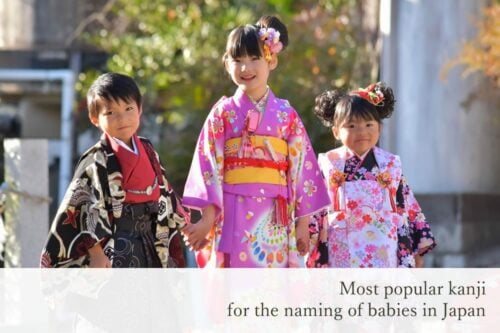Share this link via
Or copy link
Below are navigation links that will take you to the main text and navigation menus.
26,551 first names, 70,620 last names, 333,585 kanji variations.
one of the best Japanese name search tools for your baby!

In Japan, you might encounter the situation that people use suffixes to attach to their names. We tend not to call someone’s name without suffixes unless she/he is your close friend or family member.
For instance, when you were introduced to Mr. Kenji Yamada at the first meeting, you wouldn’t say him ‘hi, how are you Kenji?” It seems friendly to some people but sounds like a bit impolite.
Contents
In Japanese culture, we usually use suffixes or honorific titles with their names. That way to interact with someone can convey your respect, politeness, or intimacy. The suffixes are differed by relationships or circumstances, oral or written communication, therefore, there are a lot of different types of suffixes and titles of honor. This article would be helpful to remember the rules to use.
It is a very common suffix and usually used with intimacy for children and females or pets, however, it also used for males and older people. It sometimes used by close friends regardless of they are adults or children.
ex: Mariko-chan (まりこちゃん) ![]() , Ken-chan (けんちゃん)
, Ken-chan (けんちゃん) ![]()
In modern days, this suffix is the designation of members of the family in general.
ex: onī-chan (お兄ちゃん) meaning:brother ![]() , onē-chan (お姉ちゃん) meaning:sister
, onē-chan (お姉ちゃん) meaning:sister ![]() , ojī-chan (おじいちゃん) meaning:grandfather
, ojī-chan (おじいちゃん) meaning:grandfather ![]() , obā-chan (おばあちゃん) meaning:grandmother
, obā-chan (おばあちゃん) meaning:grandmother ![]() , etc.
, etc.
The suffix is commonly used for boys (both child and adult) with the same grade or younger. And there is sometimes the case when a male leader calls a female junior worker to attach “~kun”.
ex: Yamada-kun (やまだ君) ![]() , Haruto-kun (はると君)
, Haruto-kun (はると君) ![]()
The suffix is for an unmarried female. When “~kun” is used for only boys, “jō” is applied to girls, however, it is not commonly used these days.
ex: Yamada-jō (やまだ嬢) ![]() , Mariko-jō (まりこ嬢)
, Mariko-jō (まりこ嬢) ![]()
It is the most common suffix and it is used verbally and written, also it can be suitable for any situation to show your politeness. It is used with younger, the same grade, or older people at the first meeting. It can be useful if it is uncertain to make sure a person’s title or grade.
ex: Yamada-san (やまださん) ![]() , Mariko-san (まりこさん)
, Mariko-san (まりこさん) ![]()
In modern days, this suffix is the designation of members of family or relatives in general.
ex: otō-san (お父さん) meaning:father ![]() , okā-san (お母さん) meaning:mother
, okā-san (お母さん) meaning:mother ![]() , oji-san (おじさん) meaning:uncle
, oji-san (おじさん) meaning:uncle ![]() , oba-san (おばさん) meaning:anty
, oba-san (おばさん) meaning:anty ![]() , etc.
, etc.
It is frequently used in business occasions. “Sama” is an honorific title that used for sending a letter to an individual with no matter if the person is older or younger. In addition to the situation, it sometimes used verbally in the hospitality industry such as luxury hotels or fine restaurants.
ex: (a receptionist at a hotel) Yamada-sama (やまだ様) ![]() , thank you for visiting us.
, thank you for visiting us.
It is generally not used in spoken language but is written in a formal situation such as media or newspaper. It used to be for the only male, however, it is also used for females in modern days.
ex: Yamada-shi (やまだ氏) ![]() , Nakamura Tomoko-shi (なかむら ともこ氏)
, Nakamura Tomoko-shi (なかむら ともこ氏) ![]()
It is used to call someone’s wives and usually, their husband has high social status.
ex: Yamada-fujin (やまだ夫人) ![]()
It is used for a woman who has a high social status such as a doctor, lawyer, or politician. The word joshi comes from Chinese woman who handled the clerical work of record keeping in ancient times; in modern Japan it is old-fashioned.
ex: Yamada-joshi (やまだ女史) ![]()
“Sensei” means a teacher, and it can be used as a title for those who have occupations including kindergarten teacher, school teacher, professor, doctor, lawyer, minister, politician, author, artist, or cartoonist, etc. It is used as an honorific.
ex: Yamada-sensei (やまだ先生) ![]()
It refers to a senior person who has joined in school, organization, or any community before you. Regardless of age or gender, it is used for a person who has experienced more than you.
ex: Yamada-senpai (やまだ先輩) ![]()
It is generally considered to be a word that is used in written for a public announcement or official document, also is used by senior to junior, therefore, it can be avoided to use for clients or business partners.
ex: Yamada Kazuya-dono (山田かずや殿) ![]() (in an internal document from CEO to a project leader)
(in an internal document from CEO to a project leader)
Depends on the company, sometimes people often call someone’s name with their title. Sometimes the title itself is used as a substitute for the person’s name. If the organization doesn’t emphasize hierarchy, they usually call each other names with “~san”, without their title.
In terms of professors, lawyers, doctors, they are referred to as the previously mentioned “sensei,” or they may be referred to as honorific titles after their names.
ex: Yamada-professor → Yamada-sensei (やまだ先生) ![]() , Nakamura-lawyer → Nakayama-sensei (なかやま先生)
, Nakamura-lawyer → Nakayama-sensei (なかやま先生) ![]()
Governmental positions are also honorific titles after their names such as Prime Minister, Governor, Mayor, Ambassador, etc.
Abe-Prime Minister → あべ首相 ![]() , Yamada-Ambassador → やまだ大使
, Yamada-Ambassador → やまだ大使 ![]() , Yoshimura-Governor of Osaka prefecture → よしむら知事
, Yoshimura-Governor of Osaka prefecture → よしむら知事 ![]()
All of these titles themselves are honorific titles, therefore, they are not used in combination with honorific titles and suffixes.
Bad examples: Yamada-president-sama, Yamada-sensei-sama, Yamada-lawyer-san
If you are unsure of the person’s position or age at the first meeting, you can use “~san” so that it wouldn’t be taken impolite to them. Also, if you meet a child, you can use “~chan” to attach to the name, and it may be more appropriate to use “~kun” for boys over the age of 4 or 5.
Those rules may seem to be difficult as they are considered and influenced by their occupation, gender, age difference, or relationship. It would be useful if you remember the suffixes or honorifics to built friendships and communicate with Japanese people smoothly.



Sort by: Most Kanji Variations
Sorts names by how many different kanji spellings they have. In general, names with more variants tend to be more familiar and widespread in Japan (with some exceptions).
Sort by: Most Viewed
Sorts names by page views on this site. Views reflect global traffic (including Japan), so this does not represent popularity among Japanese people only. A high view count does not necessarily mean the name is famous in Japan.
What is Hiragana?
Hiragana is one of the two Japanese syllabaries. Each character represents a sound (mora), not a meaning. It is used for native words, grammatical particles, verb/adjective endings (okurigana), and to show pronunciation above kanji (furigana). It developed from cursive forms of kanji.
What is Katakana?
Katakana is one of the two Japanese syllabaries. Each character represents a sound (mora), not a meaning. It is mainly used to write foreign words and names, loanwords, onomatopoeia, and for emphasis.
What is English Transcription?
“English transcription” (romanization) is the romanized form of a Japanese name, intended to reproduce its pronunciation as closely as possible. It is also useful for searching names on this site.
Japanese-Style Nicknames
In Japan, nicknames are used to express familiarity and affection. Typical features include:
Shortened forms: Names are often shortened for closeness, e.g., “Yuki” from “Yukiko” or “Taka” from “Takashi”.
Suffixes: Terms like “-chan” (often for girls, also for young children) and “-kun” (often for boys) are used among family and close friends. Among very close adults, “-chan” may still be used. More details
Use & context: Nicknames are informal—common among friends, family, or close colleagues—and are not suitable for formal or professional settings. Their use implies a certain degree of intimacy.
Long vowels: The long vowel mark “chōonpu” (ー) extends the preceding vowel. For example, “あーちゃん” (A-chan) lengthens the “あ” sound.
Households
Sorts surnames by the estimated number of Japanese households that use them. More households generally indicates a more common or well-known surname.
About our last-name data
